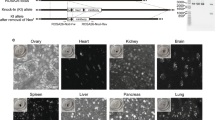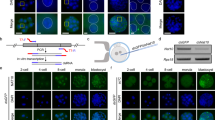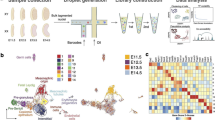Abstract
In lecanoid Coccids, or mealybugs, the male development is accompanied by the facultative heterochromatization of the entire, paternally derived, haploid chromosome set. This epigenetic phenomenon occurs in all the cells of mid-cleavage male embryos. Consequently, the Coccid chromosome system offers a powerful tool for gaining insights into the structure of facultative heterochromatin, and into the epigenetic mechanisms of its imprinted, developmentally regulated formation. This paper will present new data and summarize recent studies on genomic imprinting and facultative heterochromatization in mealybugs. First, the existence and the possible role of DNA methylation as an epigenetic modification that fulfills the requisites of the imprinting process in mealybugs will be considered. The second part of this paper will focus on proteins involved in the facultative heterochromatization process. In particular, the involvement of an HP-1-like protein in the silencing of the paternally derived haploid chromosome set and its interaction with the lysine 9 methylated isoform of histone H3 will be discussed.
Similar content being viewed by others
References
Achwal, C.W., C.A. Iyer & H.S. Chandra, 1983. Immunochemical evidence for the presence of 5mC, 6mA and 7mG in human, Drosophila and mealybug DNA. FEBS Lett. 158: 353–358.
Bannister, A.J., P. Zegerman, J.F. Partridge, E.A. Miska, J.O. Thomas, R.C. Allshire & T. Kouzarides, 2001. Selective recognition of methylated lysine 9 on histone H3 by the HP1 chromo domain. Nature 410: 120–124.
Boggs, B.A., P. Cheung, E. Heard, D.L. Spector, A.C. Chinault & C.D. Allis, 2002. Differentially methylated forms of histone H3 show unique association patterns with inactive human X chromosomes. Nat. Genet. 30: 73–76.
Bongiorni, S., O. Cintio & G. Prantera, 1999. The relationship between DNA methylation and chromosome imprinting in the Coccid, Planococcus citri. Genetics 151: 1471-1478.
Bongiorni, S., M. Mazzuoli, S. Masci & G. Prantera, 2001. Facultative heterochromatization in parahaploid male mealybugs: involvement of a heterochromatin-associated protein. Development 128: 3809-3817.
Brown, S.W. & F.D. Bennett, 1957. On sex determination in the diaspine scale Pseudalacaspis pentagona (Targ.) (Coccoidea). Genetics 42: 510–523.
Brown, S.W. & W.A. Nelson-Rees, 1961. Radiation analysis of a lecanoid genetic system. Genetics 46: 983-1007.
Brown, S.W. & U. Nur, 1964. Heterochromatic chromosomes in the coccids. Science 145: 130–136.
Buglia, G., V. Predazzi & M. Ferraro, 1999. Cytosine methylation is not involved in the heterochromatization of the paternal genome of mealybug Planococcus citri. Chromosome Res. 7: 71–73.
Clemson, C.M., J.A. McNeil, H.F. Willard & J.B. Lawrence, 1996. XIST RNA paints the inactive X chromosome at interphase: evidence for a novel RNA involved in nuclear/chromosome structure. J. Cell. Biol. 132: 259–275.
Cowell, I.G., R. Aucott, S.K. Mahadevaiah, P.S. Burgoyne, N. Huskisson, S. Bongiorni, G. Prantera, L. Fanti, S. Pimpinelli, R. Wu, D.M. Gilbert, W. Shi, R. Fundele, H. Morrison, P. Jeppesen & P.B. Singh, 2002. Heterochromatin, HP1 and methylation at lysine 9 of histone H3 in animals. Chromosoma 111: 22–36.
Crouse, H.V., 1960. The controlling element in sex chromosome behavior in Sciara. Genetics 45: 1429-1443.
Devajyothi, C. & V. Brahmachari, 1992. Detection of a CpA methylase in an insect system: characterization and substrate specificity. Mol. Cell Biochem. 110: 103–111.
Eissenberg, J.C. & S.C.R. Elgin, 2000. The HP1 protein family: getting a grip on chromatin. Curr. Opin. Genet. Dev. 10: 204–210.
Eissenberg, J.C., T.C. James, D.M. Foster-Hartnett, T. Hartnett, V. Ngan & S.C.R. Elgin, 1990. Mutation in a heterochromatinspecific chromosomal protein is associated with suppression of position-effect variegation in Drosophila melanogaster. Proc. Natl. Acad. Sci. USA 87: 9923-9927.
Epstein, H., T.C. James & P.B. Singh, 1992. Cloning and expression of Drosophila HP1 homologs from a mealybug, Planococcus citri. J. Cell. Sci. 101: 463–474.
Ferguson-Smith, A.C. & M.A. Surani, 2001. Imprinting and the epigenetic asymmetry between parental genomes. Science 293: 1086-1089.
Ferraro, M., G.L. Buglia & F. Romano, 2001. Involvement of histone H4 acetylation in the epigenetic inheritance of different activity states of maternally and paternally derived genomes in the mealybug Planococcus citri. Chromosoma 110: 93–101.
Field, L.M., 2000. Methylation and expression of amplified esterase genes in the aphid Myzus persicae (Sulzer). Biochem. J. 349: 863–868.
Field, L.M., R.L. Blackman, C. Tyler-Smith & A.L. Devonshire, 1999. Relationship between amount of esterase and gene copy number in insecticide-resistant Myzus persicae (Sulzer). Biochem. J. 339: 737–742.
Gerbi, S.A., 1986. Unusual chromosome movements in Sciarid flies, pp. 71-104 in Results and Problems in Cell Differentiation, Vol. 13: Germ Line-Soma Differentiation, Chapter 2, edited by W. Hennig. Springer-Verlag, Berlin.
Goday, C. & M.R. Esteban, 2001. Chromosome elimination in sciarid flies. Bioessays 23: 242–250.
Herzing, L.B., J.T. Romer, J.M. Horn & A. Ashworth, 1997. Xist has properties of the X-chromosome inactivation centre. Nature 386: 272–275.
Hughes-Schrader, S., 1948. Cytology of Coccids (Coccoidea-Homoptera). Adv. Genet. 2: 127–203.
Hung, M.S., N. Karthikeyan, B. Huang, H.C. Koo, J. Kiger & C.J. Shen, 1999. Drosophila proteins related to vertebrate DNA (5-cytosine) methyltransferases. Proc. Natl. Acad. Sci. USA 96: 11940-11945.
Hwang, K.K., J.C. Eissenberg & H.J. Worman, 2001. Transcriptional repression of euchromatic genes by Drosophila heterochromatin protein 1 and histone modifiers. Proc. Natl. Acad. Sci. USA 98: 11423-11427.
James, T.C. & S.C.R. Elgin, 1986. Identification of nonhistone chromosomal protein associated with heterochromatin in Drosophila and its gene. Mol. Cell. Biol. 6: 3862-3872.
Jeppesen, P. & B.M. Turner, 1993. The inactive X chromosome in female mammals is distinguished by a lack of histone H4 acetylation, a cytogenetic marker for gene expression. Cell 74: 281–289.
Jenuwein, T. & C.D. Allis, 2001. Translating the histone code. Science 293: 1074-1080.
Lachner, M., D. O'Carroll, S. Rea, K. Mechtler & T. Jenuwein, 2001. Methylation of histone H3 lysine 9 creates a binding site for HP1 proteins. Nature 410: 116–120.
Lee, J.T. & R. Jaenisch, 1997. Long-range cis effects of ectopic X-inactivation centres on a mouse autosome. Nature 386: 275–279.
Lewin, B., 1998. The mystique of epigenetics. Cell 93: 301–303.
Lloyd, V., 2000. Parental imprinting in Drosophila. Genetica 109: 35–44.
Lorentz, A., K. Ostermann, O. Fleck & H. Schmidt, 1994. Switching gene swi6, involved in repression of silent matingtype loci in fission yeast, encodes a homologue of chromatinassociated proteins from Drosophila and mammals. Gene 143: 323–330.
Lyko, F., 2001. DNA methylation learns to fly. Trends Genet. 17: 169–172.
Lyon, M.F., 1992. Some milestones in the history of X-chromosome inactivation. Annu. Rev. Genet. 26: 16–28.
Moore, T. & D. Haig, 1991. Genomic imprinting in mammalian development: a parental tug-of-war. Trends Genet. 7: 45–49.
Noma, K., C.D. Allis & S.I. Grewal, 2001. Transitions in distinct histone H3 methylation patterns at the heterochromatin domain boundaries. Science 293: 1150-1155.
Nur, U., 1967. Reversal of heterochromatization and the activity of the paternal chromosome set in the male mealybug. Genetics 56: 375–389.
Nur, U., 1990. Heterochromatization and euchromatization of whole genomes in scale insects (Coccoidea: Homoptera). Development (Suppl.) 29–34.
Penny, G.D., G.F. Kay, S.A. Sheardown, S. Rastan & N. Brockdorff, 1996. Requirement for Xist in X chromosome inactivation. Nature 379: 131–137.
Peters, A.H., J.E. Mermoud, D. O'Carroll, M. Pagani, D. Schweizer, N. Brockdorff & T. Jenuwein, 2002. Histone H3 lysine 9 methylation is an epigenetic imprint of facultative heterochromatin. Nat. Genet. 30: 77–80.
Peterson, K. & C. Sapienza, 1993. Imprinting the genome: imprinted genes, imprinting genes, and a hypothesis for their interaction. Annu. Rev. Genet. 27: 7–31.
Razin, A. & H. Cedar, 1994. DNA methylation and genomic imprinting. Cell 77: 473–476.
Reik, W. & J. Walter, 1998. Imprinting mechanisms in mammals. Curr. Opin. Genet. Dev. 8: 154–164.
Scarbrough, K., S. Hatiman & U. Nur, 1984. Relationship of DNA methylation level to the presence of heterochromatin in mealybugs. Mol. Cell. Biol. 4: 599–603.
Tweedie, S., J. Charlton, V. Clark & A. Bird, 1997. Methylation of genomes and genes at the invertebrate-vertebrate boundary. Mol. Cell. Biol. 17: 1469-1475.
Weiler, K.S. & B.T. Wakimoto, 1995. Heterochromatin and gene expression in Drosophila. Annu. Rev. Genet. 29: 577–605.
Author information
Authors and Affiliations
Rights and permissions
About this article
Cite this article
Bongiorni, S., Prantera, G. Imprinted Facultative Heterochromatization in Mealybugs. Genetica 117, 271–279 (2003). https://doi.org/10.1023/A:1022964700446
Issue Date:
DOI: https://doi.org/10.1023/A:1022964700446




